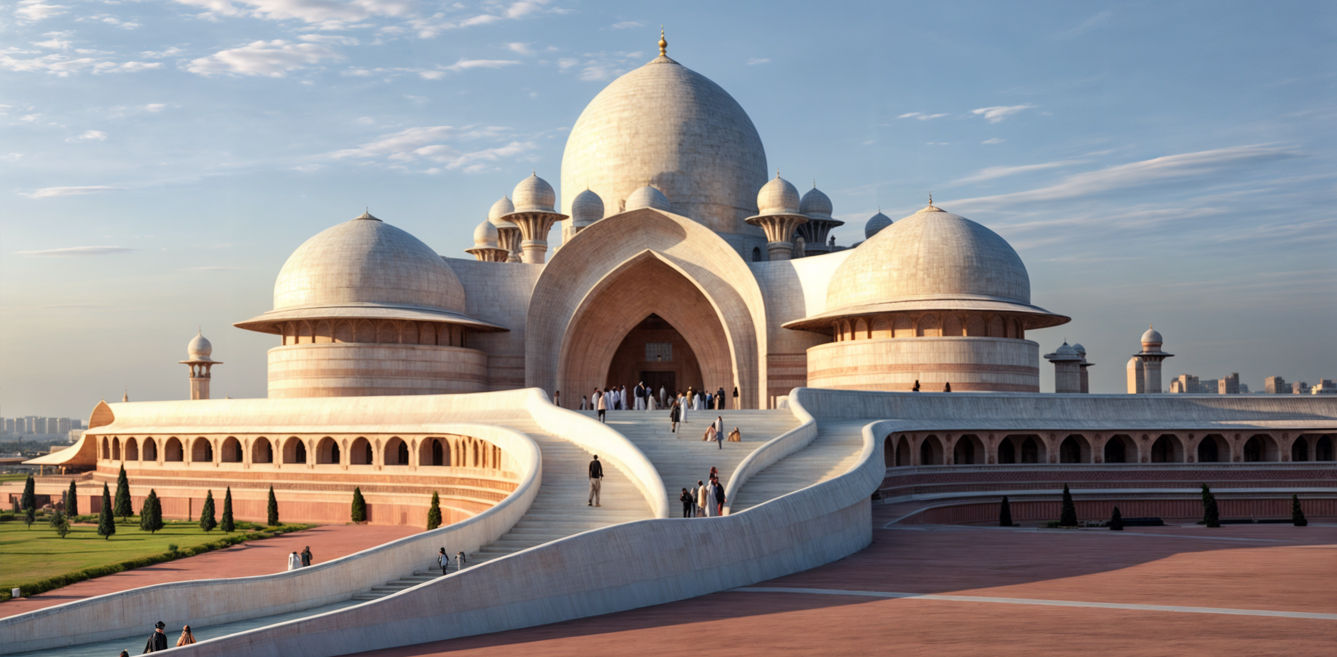

Islam made contacts with the Indian subcontinent in the 7th century through trade routes linking Arabia with the western coast of India, initially focusing on the Malabar coast in the extreme southwest. By the early 8th century, an Islamic army led by Arab general Muhammad bin Qasim invaded Sindh (now part of Pakistan). Over the following centuries, the Indus River delineated the eastern extent of Islamic influence. It wasn’t until the transition from the 12th to the 13th century that the Persian Ghurid dynasty in Bengal gained control over the entire Gangetic plain. This event marked the definitive beginning of the Islamic era in India. The result was land dotted with mind-boggling architecture — bulbous domes, slender minarets with cupolas and intricate jali work. Unfortunately, with the infiltration of western design trends, Islamic architecture became increasingly confined to religious constructions and underwent modernisation like many other architectural styles. Manas Bhatia, an architect and a visual artist took on the responsibility of reintroducing us to our rich history (through a contemporary perspective) with Fluid Mughal Marvels.
This project takes one to a world where Mughal architecture intertwines with the futuristic fluidity of Zaha Hadid’s visionary designs. It aims to create a synthesis where the intricate artistry of Mughal design converges with the dynamic, organic forms characteristic of Zaha Hadid’s work. Traditional Mughal domes and arches gracefully morphing into contemporary, flowing shapes, illuminated by a mesmerising interplay of light and shadow.
The integration of AI marks a pivotal moment in architectural history, showcasing the transformative potential of technology in creative fields. Tools like MidJourney enable architects to visualise and conceptualise designs that push beyond the conventional boundaries of architecture. By leveraging AI’s computational power, architects can explore complex, avant-garde forms and materials that would otherwise be challenging to conceive and execute.
Moreover, AI in architectural design fosters a positive cycle of innovation. By facilitating the visualisation of bold ideas, AI inspires architects and designers to push the envelope further, driving the evolution of new architectural styles.
Fluidic Mughal Marvels is a celebration of the integration of the past and the future. Through AI, this initiative heralds a new era in architecture—one where traditional elements coexist with modern advancements.
Architecturally, the project begins with a meticulous deconstruction of Mughal and Zaha Hadid styles into their fundamental elements. These elements serve as prompts for AI tools like MidJourney, which then translate them into visual concepts. Through iterative refinement, guided by human creativity and AI capabilities, novel ideas emerge, enriching the final design with unexpected insights and possibilities.
AI tools are revolutionizing architectural practice by expediting design processes and enhancing creative exploration. From rapid visualization of design concepts to precise 3D modeling and automated drafting, AI streamlines workflow efficiencies. Tools like Lumion and integrated CAD software empower architects to communicate ideas effectively and respond swiftly to client feedback. Moreover, AI-assisted scripting reduces technical burdens, allowing architects to focus more on innovation and design excellence.
As this project continues to evolve, it not only sets a new standard for architectural innovation but also inspires a global community of architects to embrace AI as a catalyst for limitless creative expression.
Also Read: Exploring the unseen through Hassan Ragab’s AI work, influenced by Egypt
The architectural landscape of Rajasthan is steeped in a rich tradition of historic masonry, reflecting…
Are you a corporate employee spending 10+ hours in an ordinary cubicle that's fused in…
Modern Indian homes are no longer bound by their physical vicinity. They have outgrown our…
Häcker Kitchens, a brand synonymous with quality and innovation, has a rich legacy that spans…
In this home designed by Sonal R Mutha and Aniketh Bafna, founders and principal designers…
Essentia Home’s journey in redefining luxury interiors took a bold new step as it opened…